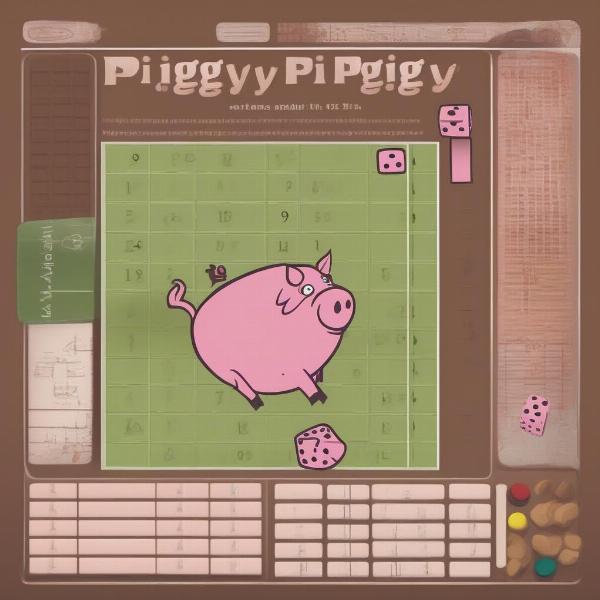Piggy Piggy, also known as Pig or Pass the Pigs, is a simple yet surprisingly strategic dice rolling game that can be enjoyed by players of all ages. It’s perfect for family gatherings, parties, or a quick game night with friends. Learn how to play Piggy Piggy and discover the nuances of this addictive dice game.
Understanding the Basics of Piggy Piggy
Piggy Piggy revolves around rolling a pair of specialized dice shaped like pigs. Each side of the pig die represents a different scoring position, each with its own point value. The objective of the game is to be the first player to reach a predetermined score, typically 100 points.
How to Play Piggy Piggy: A Step-by-Step Guide
- Gather your materials: You’ll need two pig dice and something to keep score, like a pen and paper or a scoring app.
- Determine the target score: Decide on the winning score, usually 100.
- Roll the dice: The first player rolls both pig dice simultaneously.
- Score your roll: Each pig die position corresponds to a specific point value. The common scoring positions are:
- Sider: 0 points (Also known as “Dot”, depending on dice design) Forces the player to end their turn and forfeit all points accumulated in that turn.
- Razorback: 5 points (Pig on its back)
- Trotter: 5 points (Pig on its feet)
- Snouter: 10 points (Pig on its nose)
- Leaning Jowler: 15 points (Pig resting on its snout and ear)
- Decide to roll again or bank: If you didn’t roll a Sider, you can choose to roll again and accumulate more points, or “bank” your current turn’s score and pass the dice to the next player.
- Rolling a Sider: If you roll a Sider on either die, your turn ends immediately, and you lose all points accumulated in that turn.
- Pig Out: If you roll two Siders (a “Pig Out”), you lose all your accumulated points, resetting your score to zero.
- Winning the game: The first player to reach or exceed the target score wins.
Advanced Strategies and Tips for Piggy Piggy
While Piggy Piggy relies heavily on luck, there’s a layer of strategy involved in deciding when to roll and when to bank.
- Risk vs. Reward: The longer you roll, the more points you can potentially accumulate, but the risk of rolling a Sider and losing everything increases with each roll.
- Observe Patterns (or lack thereof): While the dice rolls are random, some players believe they can discern patterns. Pay attention to your rolls and see if you can identify any tendencies. However, remember that this is primarily a game of chance.
- Set a Turn Goal: Consider setting a point goal for each turn. For example, aim to score 20 points per turn. This can help you manage risk.
- Opponent Awareness: Pay attention to your opponents’ scores. If someone is close to winning, you might take more risks to catch up.
 Example of Piggy Piggy Gameplay
Example of Piggy Piggy Gameplay
Variations of Piggy Piggy
There are several variations of Piggy Piggy, including:
- Double Leaning Jowler Bonus: Awarding bonus points (e.g., 100 points) for rolling two Leaning Jowlers simultaneously.
- Making Rain: In this variation, rolling a Sider on one die and any scoring position on the other only results in losing the points for the current turn, not the entire accumulated score.
- Single Die Pig: Play with only one pig die for a simpler, faster game.
Piggy Piggy and Probability
The probability of rolling each position on a pig die influences the strategic decisions you make. While calculating exact probabilities can be complex, understanding the general likelihood of each outcome can inform your gameplay. For instance, the Sider is typically the most common roll, making it crucial to manage your risk accordingly.
Why Play Piggy Piggy?
Piggy Piggy is a fun, fast-paced game that requires minimal setup and can be enjoyed by players of all ages. Its blend of luck and simple strategy makes it engaging for both casual and more competitive gamers.
“Piggy Piggy is a fantastic game for teaching children about probability and risk assessment in a fun, engaging way.” – Dr. Emily Carter, Educational Psychologist
“I love the simplicity of Piggy Piggy. It’s easy to learn but still offers enough strategic depth to keep things interesting.” – Mark Johnson, Board Game Enthusiast
Conclusion
Piggy Piggy is a delightful dice game that combines luck and strategy in a simple yet engaging package. By understanding the rules, scoring, and strategic nuances, you’ll be well-equipped to enjoy this classic game. So, gather your friends and family, grab some pig dice, and see who can become the Piggy Piggy champion! Now that you know How To Play Piggy Piggy Card Game (it’s dice, not cards, but we covered that!), get rolling!
FAQ
- What is the objective of Piggy Piggy? The objective is to be the first player to reach a predetermined score, usually 100.
- What happens if I roll a Sider? If you roll one Sider, your turn ends and you lose all points from that turn. Two Siders (Pig Out) resets your total score to zero.
- How do I win Piggy Piggy? The first player to reach or exceed the target score wins.
- Is there a strategy to Piggy Piggy? While luck plays a large role, strategic decisions about when to roll and when to bank are crucial.
- Can I play Piggy Piggy with only one die? Yes, you can play a simplified version with a single die.
- What is a Leaning Jowler? A Leaning Jowler is a scoring position where the pig die rests on its snout and ear, typically worth 15 points.
- Where can I buy Piggy Piggy dice? Piggy Piggy dice can be purchased online or at most toy and game stores.

